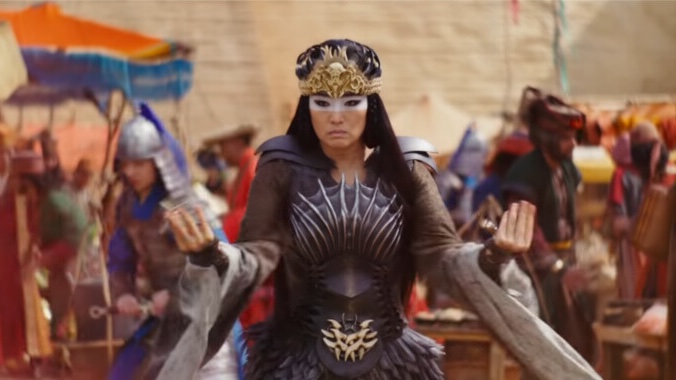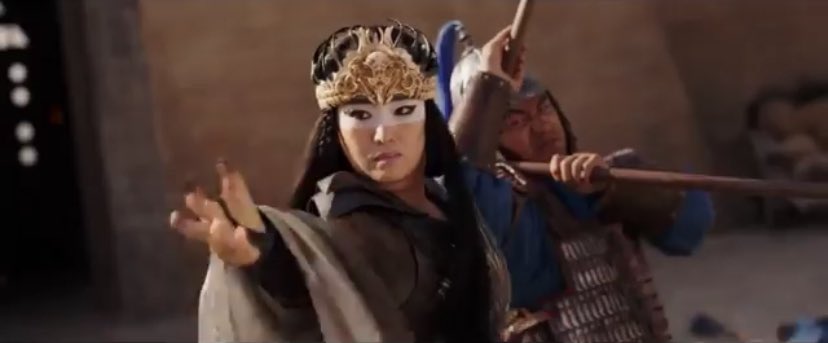
Below the Line has a fairly extensive interview with Weta Digital VFX Supervisor Anders Langlands, who recently supervised the visual FX for Disney’s Mulan. We wanted to give you a little taster for that upcoming interview with a fairly lengthy description of one particular scene that Weta made happen.
One of Mulan’s two primary antagonists is a sorceress named Xianniang, played by Gong Li. In one particularly striking sequence, she leaves the palace of the Emperor disguised as a soldier before transforming back into herself and then transforming once again into a hawk as she flies off. Weta did a number of those transformation sequences, but Langlands told us what was involved with that particularly complex sequence.
The first challenge was to find the right location to shoot that scene. “We decided to shoot it in China on the actual location,” Langlands told us. “It would have been potentially more controlled on green screen in Auckland but then you’d have to deal with not having natural lighting and not having the actual location — having to basically build all of that stuff yourself. We decided to shoot it in China in an alleyway at that XY Studios Park, which was very tight and limited, so we couldn’t do anything like motion control, which would make putting the final shot together considerably more difficult, but I think worth it in terms of the quality light that we got.”
“That was shot in multiple passes, one for the soldier walking, one for the witch walking and then a clean plate,” he continued. “The witch walking was played by Yaxi [Liu], who is one of Yifei [Liu’s] stunt doubles on a wire, so that when she gets to the end of the alleyway, she does an assisted leap, and then spins in midair with a tug. We basically used that motion in order to drive the transformation. That twisting motion that she does, then gives us like a way to do the blend, because we’re obviously taking a full-size woman and transforming her into a bird. If there’s a bit of a scale difference there, you have to try and hide that somehow. [Director] Nikki [Caro] throughout the process – the words she kept coming back to were “grace and elegance.” She wanted to keep things kind of more naturalistic. If you’re doing visual effects or transformation like that, one of the things that they try and hide the joins essentially is to cover it in lights and colors and do magic-y-looking stuff like fairy dust, that kind of thing. That was the exact opposite of what Nikki wanted to do. She wanted to do something more realistic, much more slight of hand, which is really cool, because it’s a much more interesting way, but also, it’s much more difficult, because you’re trying to hide stuff in plain sight.
“We took those three shots — the soldier plate, the witch plate, and the clean plate – and we rebuilt the background and extracted the soldier and the witch from their plate. We had to retime them a bit to get the pacing of the walk to line up, because a man and a woman have very different gaits and stride lengths, so we had to try and sync those up as best we could afterwards. We then created digital versions for the soldier and the witch — the hawk was fully digital – which we then roto-animated to match their walks. Because we didn’t want to do something big and flashy, we tried to blend the photographic plates the best we could and just used the digital versions of those characters for areas to essentially hide the joins and smooth out the transitions and make it much more elegant.

“The soldier is walking and the skirt thing on his armor basically starts to transform into the equivalent piece on the witch, which is a very different shape, so each of the shorter armor plates transform into longer scales that the witch has on her costume, and the whole thing grows down a little bit. We then have a digital sleeve that unfurls from the witch’s arms, which are out of cameras, so there’s a digital cloth simulation which comes down and then that seamlessly blends with the real sleeve from the plate. We use that as an element to wipe between the digital witch and the real witch. I think she’s got a digital bottom half for most of the shots and then the boots change shape, and we try to time that motion with the rhythm of her walking to make it feel a bit more lyrical, a bit more natural.”
In fact, the way the witch’s costume is used throughout the film, including in an impressive fight sequence, is partially what makes the movie’s visual FX so jaw-dropping. “We were trying to do the cloth thing for the sleeves and ended up building a digital costume for the witch. Costume sent us the pattern for the witch’s costume, as well as photographs and samples, as well as obviously both Yaxi and Gong Li in the costume. It was such a complex thing in terms of the different types of fabric. It’s an absolutely beautiful costume, stunning. There was a lot of love and attention to put into it.”
“It’s really interesting because it almost happens without you realizing what you’re looking at,” he concluded about the transformation sequence. “You sort of go through, and then, before yu know it, she’s into the witch and then into the hawk without any big signifier that something is happening. I think we really nailed the elegance, so that was a lot of fun.” (You can see a small portion of this final transformation at the 1:28 mark in the trailer below.)
We’ll have a lot more from our interview with Langlands very soon. Mulan is still available via Premium Disney+ for an additional fee until December when it will be available to all Disney+ subscribers. You can also read Below the Line’s review of the film.





